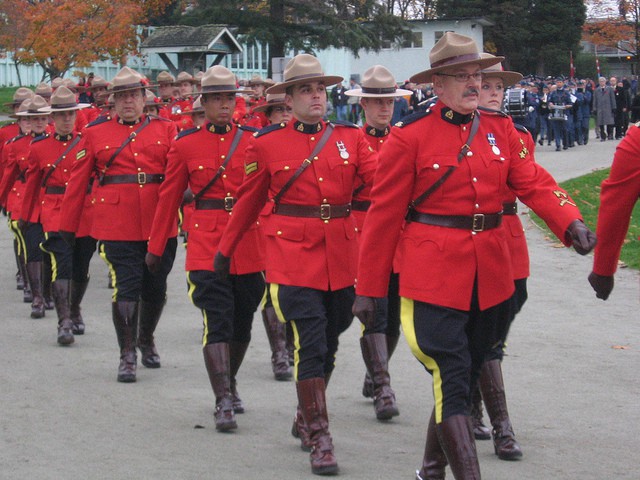 Creativecommons.org/Marcin Chady
Creativecommons.org/Marcin Chady
The province of Saskatchewan is synonymous with the Royal Canadian Mounted Police.
On May 1873, the Dominion Parliament passed an act to provide for the establishment of a ‘Mounted Police Force for the North-West Territories’. A year later, the famous ‘March West’ brought 300 original members of the NWMP to what is now Saskatchewan and Alberta.
The headquarters of the force relocated several times from Fort Garry, Fort Dufferin, Swan River, Fort Macleod and Fort Walsh, before finally settling on a more centralized location beside Wascana Creek, on the outskirts of Regina in 1882.
Today, the RCMP’s ‘Depot’ Division, which is located in Regina, is considered to be the ‘Cradle of the Force’, because all RCMP members receive their training there. Over 1,000 new Mounties graduate each year. This is just one of the reasons why the province of Saskatchewan and the RCMP go hand in hand. Here are some of the other reasons why Saskatchewan has a special place at the heart of the force.
The RCMP Heritage Centre
 Creativecommons.org/sunchild123
Creativecommons.org/sunchild123
Located adjacent to the academy, the RCMP Heritage Centre chronicles the story of the force from the lawless days of the old west, to the challenges of policing in the north and today’s modern forensic technology.
Opened in 2007, the centre is a stunning glass and stone facility designed by world-renowned architect Arthur Erickson. State-of-the-art technology and multimedia rich galleries educate visitors about the vital role the RCMP has played in shaping Canada’s past and present.
Immerse yourself in the story of the North West Mounted Police’s march to tame the Wild West and how their name came to be the Royal Canadian Mounted Police. Learn about Sitting Bull, the gold rush and the North West Resistance and find out more about those beautiful black horses used in the Musical Ride.
New ‘Depot’ Driving Tour
This summer sees the launch of new electric tram tours of the RCMP Academy’s ‘Depot Division’. The tours give visitors the opportunity to see beyond the public areas of the Parade Square, RCMP Cenotaph and Chapel, and introduce them to many of our venues that support the success of the Cadet Training Program. The tours begin on May 23 – the force’s 141st birthday.
Fort Walsh Historic Site
 Creativecommons.org/Brad Ovenell-Carter
Creativecommons.org/Brad Ovenell-Carter
Fort Walsh was the Mounties’ original headquarters. Travellers can follow in the footsteps of the Northwest Mounted Police who brought Canadian law to the west. Fort Walsh was one of the most important and heavily armed forts. It presided over one of the most dramatic periods of change on the Prairies. A former NWMP/RCMP post from 1875 to 1883, the fort was later used to breed horses for the Musical Ride. Costumed guides are full of information, there some nice picnic areas, a museum and period-furnished buildings to explore.
Fort Battleford National Historic Site of Canada
 Creativecommons.org/Alex Juorio
Creativecommons.org/Alex Juorio
Today's Fort Battleford commemorates the major role this fort played in the North West Resistance of 1885. Established in 1876, the fort presided over some of the most pivotal events in the history of western Canada. The North-West Mounted Police there assisted during the negotiations between First Nations and the Canadian government at the time of the signing of Treaty Six, established the rule of Canadian law and order, supervised the early settlement of the area and provided settlers from among their own retired members. Visitors can uncover the secrets of Fort Battleford on an audio tour, explore the fort’s five original buildings and discover the role that Fort Battleford played in the Armed Conflict of 1885.
Wood Mountain Post Provincial Historic Park
The pivotal location of Wood Mountain Post along the US border determined its role in the policing of the north west. A NWMP detachment patrolled the border from 1874 to 1918, regulating whiskey traders, horse thieves and cattle rustlers. Wood Mountain Post tells the tale of the friendship and respect between Major James Walsh and the legendary Sioux Chief, Chief Sitting Bull. Walsh negotiated with the chief, who brought 5,000 of his people to the Wood Mountain area after the Battle of the Little Bighorn in 1876. Saskatchewan Parks Service reconstructed several of the buildings of Wood Mountain Post in 1965 as part of the Canadian centenary.
Batoche National Historic Site
 Creativecommons.org/danrmg
Creativecommons.org/danrmg
Batoche displays the remains of the village of Batoche on the banks of the South Saskatchewan River – the location of the last battlefield in the North West Rebellion of 1885. Several buildings have been restored on the site, and visitors can learn about the lifestyles of the Métis of Batoche between 1860 and 1900 - the trails they walked, their homes, their church and the Battle of Batoche in May 1885. Batoche was declared a National Historic Site in 1923.
Fort Carlton Provincial Park
Fort Carlton Provincial Park takes you back in time to the adventurous days of the fur trade, before Canada was a country. This is the original site of a Hudson’s Bay Company fur-trading post that operated between 1810 and 1885. Today, you can see a fur and provisions store, a trade store, the clerk’s quarters and a tepee encampment. Check out the fur trade displays in the visitor centre, have a leisurely lunch in the picnic area, or camp for the night in the park’s campsite.


